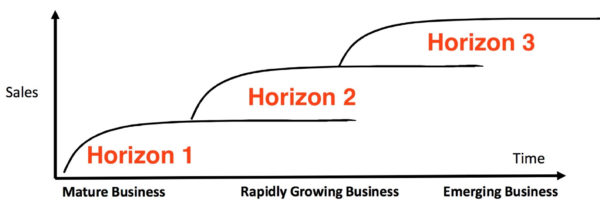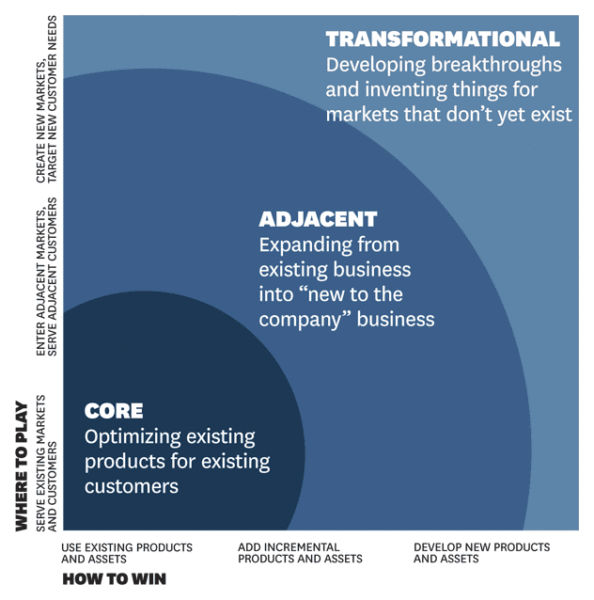When Should We Apply The Lean Startup Approach?

Since our co-founder Eric Ries published The Lean Startup in 2011, organizations around the globe have been applying The Lean Startup methodology to an ever-growing number and variety of business challenges. Here at Lean Startup Co., we’ve helped thousands of clients spanning numerous industries and geographies who represent just a fraction of organizations using The Lean Startup.
Despite those numbers, the Lean Startup method is clearly not the answer to every business problem. So how do leaders know when it’s appropriate to deploy it? How do they determine which situations and parts of their businesses would benefit from using it? We’ve seen that the vast majority of organizations use one of the two following models, or a combination of both, to answer these questions and guide their thinking about how and when to use The Lean Startup.
The Horizon Model
The first model, commonly known as the three horizons innovation model, was originally published in The Alchemy of Growth (2000) by Mehrdad Baghai, Stephen Coley and David White.

In this model, innovation horizons 1, 2 and 3 are differentiated as follows:
- Horizon 1 ideas provide continuous innovation to a company’s existing business model and core capabilities in the short-term.
- Horizon 2 ideas extend a company’s existing business model and core capabilities to new customers, markets, or targets.
- Horizon 3 is the creation of new capabilities and new business to take advantage of or respond to disruptive opportunities or to counter disruption.
When asking when to apply The Lean Startup approach, many organizations answer “horizons 2 and 3,” the assumption being that horizon 1 innovation is already covered by existing processes.
The ‘Core Adjacent Transformational’ Model
The second model, the Innovation Ambition Matrix, was introduced in a 2012 Harvard Business Review article, Managing Your Innovation Portfolio, by Bansi Nagji and Geoff Tuff. It’s commonly known as the “core adjacent transformational” (C-A-T) innovation model.

In the article, core innovation initiatives are described as “efforts to make incremental changes to existing products and incremental inroads into new markets” while transformational innovation initiatives are described as those “designed to create new offers — if not whole new businesses — to serve new markets and customer needs,” with adjacent innovation initiatives being stuck somewhere in between. When asking “when should we apply The Lean Startup approach?” many organizations answer “to transformational and adjacent innovation,” the assumption being that core innovation is already covered by existing processes. Note the similarity to horizon 1 in the Horizon Model.
While the C-A-T or 1-2-3 models can be useful for determining when to use Lean Startup, understanding the root cause factor that underpins both of them leads to deeper understanding. Let’s explore below.
Uncertainty Determines When To Apply Lean Startup
The Lean Startup methods are an evolving body of practical knowledge in which both new and old techniques are continuously being validated and invalidated. That being said, it’s important to keep in mind Eric Ries’s original 2011 definition of a startup, which highlights a crucial factor:
“A startup is a human institution designed to deliver a new product or service under conditions of extreme uncertainty.” —Eric Ries
If a team at Starbucks decides to open a new store location on a busy street corner, under Eric’s definition this team is not a startup, as they are not operating under conditions of extreme uncertainty. It’s 99% sure this new location is going to satisfy customers and make a profit. After all, they’ve got over 31,000 other store locations that give them high confidence that this new store will turn out just fine.
If, however, a new product development team at Starbucks is highly uncertain if customers will want a new coffee drink they thought up (maybe one with algae in it, or mushrooms), then under Eric’s definition this team is a startup. A decent litmus test for determining whether your team is a startup team is to simply ask: “Do we know if customers will truly value the new thing we’re thinking about offering?” If your team’s answer is “If we’re really honest with ourselves, we don’t know,” then you are a startup team. If your team’s answer is “yes, we know” and you can back up this claim with compelling evidence (validated learning), then you are not a startup team.
The Lean Startup approach is a structured way for startup teams to cut through the uncertainty they face in the most efficient manner possible (i.e., not spending $15M to find out you’ve built something nobody wants). If there’s no uncertainty, then The Lean Startup isn’t useful, and a different approach should be deployed such as project management, agile development, waterfall development (yes, there are still use cases for this) or Six Sigma.
How Uncertainty Plays Into Your Model
Now back to our two models. How does uncertainty play into both the C-A-T and 1-2-3 models? It’s quite clear that uncertainty increases as we move from core to adjacent to transformational innovation, and as we move from horizon 1 to 2 to 3. This is the reason that The Lean Startup is such an effective approach for adjacent-transformational and horizon 2-3 innovation, and why organizations that apply The Lean Startup to these categories of innovation are right in doing so.
However, it turns out that The Lean Startup can also be a highly effective tool for core/horizon 1 innovation. This is because even in many core/horizon 1 innovation initiatives there’s a significant amount of uncertainty. If a company is in the business of making widgets, and they aren’t sure if the new version of their widget (a core/horizon 1 initiative) will create incremental sales that meet their break-even investment forecast, then the team working on the new widget is:
- facing extreme uncertainty
- a startup team under Eric’s definition
- and should absolutely be using the Lean Startup approach to vet, shape and de-risk the new version of their widget.
After all, it’s the uncertainty itself that really matters, not whether the initiative is core, adjacent or transformational, or horizon 1, 2 or 3. The Lean Startup should be applied to any risky new business idea, regardless of which category it happens to fall into according to the C-A-T or 1-2-3 models.
In fact some of the most significant success stories we at Lean Startup Co. have seen have been on core/horizon 1 innovation projects. Two such examples:
- A leading global retailer used The Lean Startup to develop its loyalty program. After a few build-measure-learn loops, it was clear that the original program concept was flawed, and the team executed a solution pivot that significantly increased loyalty program sign-ups while at the same time reducing the cost of the program. Today that updated loyalty program has been rolled out with much success.
- A leading global manufacturer decided to kill a massive (take the number you’re thinking of and add some zeros) new product development program after The Lean Startup approach unequivocally showed that customers were not at all interested in the new product that would have been developed. Those funds were then reallocated to new product development programs that yielded an attractive composite ROI.
So if you’re at an organization asking when to apply The Lean Startup, a great first step is to look for new business ideas that contain the most uncertainty, regardless of how they are categorized according to the C-A-T or 1-2-3 models. The more uncertain the idea, the more value The Lean Startup can generate.
